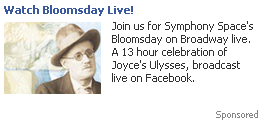As Contrary Blog’s resident Joycean, I’d been planning to be first out of the box today with a post about Bloomsday. Logging into Facebook, however, I found that no less than five of my 333 friends have already wished the world a “Happy Bloomsday.” This, I presume, triggered the following targeted ad in my Facebook account:

With the entire novel now being Tweeted, it appears that Joyce’s Odyssean Irish Jew has penetrated our collective consciousness more than I thought. So, if you aren’t already suffering from Bloomsday overload, I hereby bring to your attention to an invaluable online resource for scholars and novices alike: The James Joyce Scholars’ Collection, a free, digital trove of out-of-print classics of Joyce scholarship, compiled by David Hayman of the University of Wisconsin-Madison.
The crown jewel of this collection is undoubtedly Frank Budgen’s James Joyce and the Making of ‘Ulysses’:
In 1918, Frank Budgen was a British painter living in Zürich. When we meet him in James Joyce and the Making of ‘Ulysses’, he seems to be last person in Zürich’s artistic circles to hear of the Irishman and the forthcoming Irish epic that will change literature. When they meet, it’s perhaps for that very reason Joyce chooses Budgen as his sounding board while working on Ulysses. As Joyce claims, “[Budgen] has the advantage of me. He can understand and talk about my book, but I don’t understand and can’t talk about painting” (a statement I cannot help but find laughable–the author of Dubliners and Ulysses lacks a painterly eye!).
Budgen, who becomes a kind of Boswell to Joyce’s Dr. Johnson, brings a non-literature specialist’s perspective to Joyce’s work, and for that reason, his is still my favorite introduction to Ulysses. Thanks to Budgen, we know something of Joyce’s painstakingly slow process of composition (“Two sentences” after “working hard on it all day,” at one point).
We also get a glimpse into the great author’s home life ( “Who’s he when he’s at home?” as Molly Bloom would ask). One of the most startling moments is when we meet Joyce’s wife, Nora, so famously dismissive of her husband’ s literary endeavor s. She turns to Budgen and asks, point-blank:
“What do you think, Mr. Budgen, of a book with a big, fat, horrible married woman as the heroine? Mollie Bloom!”
Something in this statement–whether it be Budgen’s idiosyncratic spelling of Molly, or simply Nora’s directness–never fails to startle and unsettle me. It’s as startling and unsettling, in many ways, as Molly Bloom herself. It’s Molly, after all, who de-lionizes our hero, not only by making him a cuckold, but even in calling him “Poldy” (i.e. taking the “Leo” out of his name). “Her judgments of men and things were swift and forthright and proceeded from a scale of values entirely personal, unimitated, unmodified.” Budgen’s description of Nora Joyce sounds like it was intended for Molly instead.
As it happens, Budgen meets Nora with a calm reply: “I thought there was nothing wrong with being fat and married. Anyway a fat, married woman is a change from the sylph-like sweethearts we usually read about.” So true, and still true after all these Bloomsdays. So, happy Bloomsday, happy reading–or happy Tweeting, as the case may be. (Hey, Molly Bloom’s maiden name–Tweedy! OK, I promise I’ll stop.)


